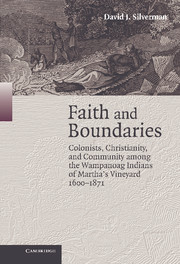 Faith and Boundaries
Faith and Boundaries Book contents
- Frontmatter
- Contents
- Maps, Tables, and Figures
- Abbreviations
- Preface: Do Good Walls Make Good Neighbors?
- Introduction: Epenow's Lessons
- 1 “Here Comes the Englishman”
- 2 To Become All Things to All Men
- 3 The Lord Tests the Righteous
- 4 Deposing the Sachem to Defend the Sachemship
- 5 Leading Values
- 6 The Costs of Debt
- 7 “Newcomers and Strangers”
- Conclusion: Fencing In, Fencing Out
- Appendix A The Population of Martha's Vineyard
- Appendix B A Cross-Comparison of Indian Race Descriptions
- Index
Preface: Do Good Walls Make Good Neighbors?
Published online by Cambridge University Press: 17 December 2010
- Frontmatter
- Contents
- Maps, Tables, and Figures
- Abbreviations
- Preface: Do Good Walls Make Good Neighbors?
- Introduction: Epenow's Lessons
- 1 “Here Comes the Englishman”
- 2 To Become All Things to All Men
- 3 The Lord Tests the Righteous
- 4 Deposing the Sachem to Defend the Sachemship
- 5 Leading Values
- 6 The Costs of Debt
- 7 “Newcomers and Strangers”
- Conclusion: Fencing In, Fencing Out
- Appendix A The Population of Martha's Vineyard
- Appendix B A Cross-Comparison of Indian Race Descriptions
- Index
Summary
The inspiration for this study came, innocently enough, with a walk along a stone wall. Linda, my fiancé (now my wife), and I were on a late May vacation after I had finished my first year of graduate school. Short of money and in desperate need of some time outside, we were lucky to have a week at a ramshackle timeshare on the island of Martha's Vineyard, just off Cape Cod in Massachusetts. I wanted this trip to be a diversion from my studies of early America, and when the island greeted us with glorious sun and lilac-perfumed sea air I knew it would not disappoint. No sooner had we set down our bags than we ventured out for a hike, unwilling to watch the day pass. An arbitrarily chosen trail led us winding through scrub pine and oak trees, past the weed-choked foundations of a colonial-era farmstead, and up a gradual peak, until it ended at a boulder split by a deep diagonal crack sitting atop a wooded hill. This landmark, our tourist literature explained, was called Waskosim's Rock and figured prominently in the oral tradition of the island's Indians, a group that I mistakenly assumed – as I soon discovered much to my embarrassment – had disappeared several generations ago, leaving whatever stories they once told about this monument to conjecture now.
- Type
- Chapter
- Information
- Faith and BoundariesColonists, Christianity, and Community among the Wampanoag Indians of Martha's Vineyard, 1600–1871, pp. xix - xxivPublisher: Cambridge University PressPrint publication year: 2005
